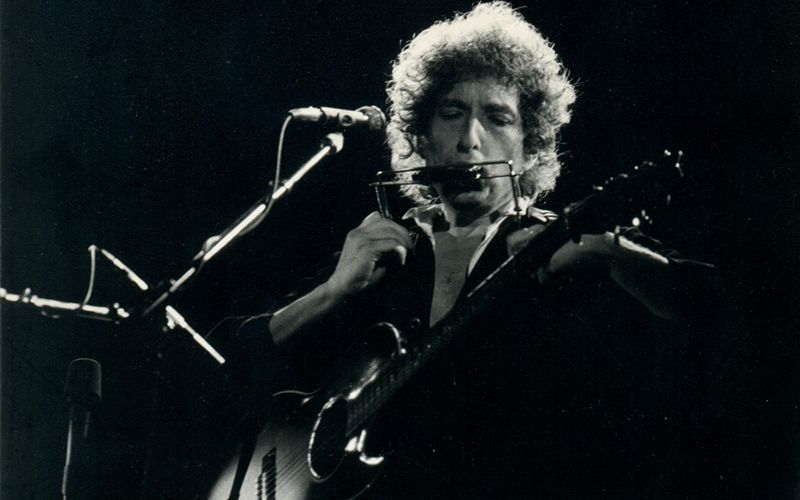I might never have become a musician if I hadn’t heard Like A Rolling Stone. That groundbreaking single sent me helter-skeltering out of womb-like Wexford and into the maelstrom of Manhattan’s Lower East Side.
I never met Dylan, though we briefly shared the same manager. However, one hungover snowy morning in Tribeca I overheard his unmistakable drawl. Sure enough, he and a lady friend were approaching me on the icy sidewalk.
As you might imagine I did a double take, whereupon he threw me a frigid glance that thundered, “Stroll on, pal!”
And I did, though I wouldn’t have known what to say anyway except, “Hey, man, any chance of an Alka-Seltzer?”
But here I was – almost a lifetime later – in Webster Bank Arena in the unaccustomed comfort of a boxed seat, far from my roots in the mosh pits of CBGB’s and Max’s Kansas City.
The opening bands, Wilco, and My Morning Jacket, were excellent – for about 30 minutes – but as their sets stretched beyond the hour mark, I had to wonder, “What are you thinking, Bobby? These guys are wearing out your audience!”
But after the rigors of 4000 or so gigs I guess Dylan doesn’t concern himself with such trivialities.
Then he was suddenly, if laconically, onstage – no announcement, just a stroll on with his band.
Nor did things click straight away. The guitarist was new, and unfamiliar with some of the songs.
The audience too seemed underwhelmed. As I made my way towards the stage people were already leaving. And then there were only three rows of diehards between me and The Man.
It was a surreal scene. Dylan doesn’t play guitar anymore and the band was gathered around him in a semi-circle. They were dressed in Tex-Mex style, but they had found the groove and were beginning to swing.
Occasionally Bob tinkered with a keyboard, but for the most part he stood out front like a weathered Old Testament prophet; however, as the set progressed and the audience thinned he became more defiant, his shades unable to mask the brittle flashes of anger.
That mattered little to the audience, many of whom were wondering aloud when he would play Just Like A Woman, Knockin’ on Heaven’s Door, or other classics.
I didn’t care. That familiar nasal voice from my youth washed over me like warm Wexford rain – comforting, nourishing, and ultimately healing.
The new songs sounded good, though I couldn’t distinguish many words; but who cared, I knew exactly what he was saying.
Dylan may be our most gifted and enduring lyricist but, like Joyce, he has transcended mere words – he speaks his own language now and its snarls, sighs, and syllables are imbued with a universe of moods and meanings.
Still the crowd got smaller and I found myself in the front row, as close as I had been on that long-ago, hung over Tribeca morning.
Then he began She Belongs To Me and I remembered singing that song for my first girlfriend back in Wexford, and with that the dam broke.
I might have been rooted to the floor in Bridgeport but I was also ricocheting around the country through a Montana sunset, a Geary Street midnight, an East Village afterhours, a Key West dawn – down all the years of knocking about on a rock & roll journey that for once made some sense.
And in those hallucinogenic moments I experienced all the strains of poetry and music in Dylan’s voice – from Congo Square in “Nawlins” up the Mississippi Delta to Route 66, and back East to Washington Square, in shades of Kerouac and Liam Clancy, Blind Willie McTell and Buddy Holly, Walt Whitman and crazy-man Allen Ginsburg howling to the moon on East 12th Street.
And then Bobby was bowing, smirking like the joker he’s always been, heading for his bus – the Voice of America off on the next leg of his everlasting tour.
Larry Kirwan was the leader of Black 47 for 25 years. He is also a playwright, novelist, and a columnist for The Irish Echo www.irishecho.com He is the host of Celtic Crush on SiriusXM Satellite Radio and President of Irish American Writers & Artists. He can be reached at blk47@aol.com and www.black47.com This article was submitted to the IrishCentral contributors network by a member of the global Irish community. It first appeared on the World News Net https://theworldnews.net/ie-news/larry-kirwan-on-the-magic-of-seeing-bob-dylan-live-for-the-first-time

